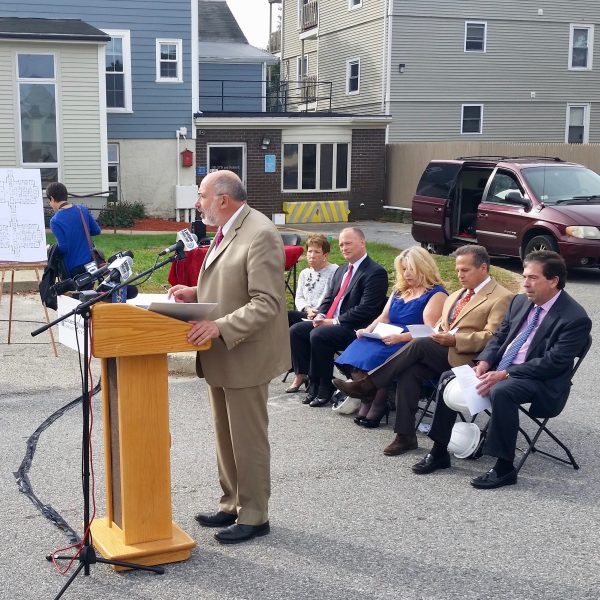
Think of it as the “Deepwater Wind” of health care: Innovation, starting in Rhode Island, that could be a model for the world. That’s how revolutionary the concept of the Neighborhood Health Station could be, and the first one is being rolled out in Central Falls.
Perhaps overshadowed by a visit from actress Viola Davis, the groundbreaking for the new Neighborhood Health Station in Central Falls heralds the beginning of a new paradigm in health care, one meant to serve the needs of the community, not the convenience of the provider. The Blackstone Valley Community Health Care (BVCHC) Neighborhood Health Station will be located at 1000 Broad St in Central Falls, and will offer primary care, walk-in primary care, dental care, a pharmacy, physical therapy, pediatric care, occupational therapy, mental health services, Ob/Gyn services, radiology and more; serving over 14,000 patients and 50,000 visits a year.
Upon completion in 2018, the city of Central Falls will benefit from having “comprehensive services offered under one roof, where clinical professionals can collaborate face-to-face for improved care coordination” and “same-day sick appointments with convenient hours (8 am to 8 pm) on week days and additional weekend hours, enabling individuals and families to access health and medical services close to home, when it is most convenient for them.”
BVCHC hopes to cover 90 percent of Central Falls residents. “Using medical records to identify at-risk patients, we will continue to collaborate using community resources and with the new health building, we are confident that we can improve public outcomes,” said BVCHC Senior Clinical and Population Health Officer Michael Fine, M.D., who now also serves as Health Policy Advisor to the City of Central Falls.
Based on public meetings with residents, three public health priorities were identified: the community wanted their kids to be safe in school, they needed access to a gymnasium and they wanted better access to primary care.
- Based on this input, the team designing the center identified five short term goals. Pregnancy prevention: BVCHC partnered with the school system and Brown University’s Residency Program in Family Medicine to create a school-based health clinic at Central Falls High School to bring prevention and same-day clinical care to the adolescents of Central Falls and to reduce the rate of adolescent pregnancy through education and prevention programs. (Central Falls’ high school pregnancy is 4X the state average).
- Multidisciplinary management of individual cases: participants in this collaboration come from all facets of the community, including doctors, dentists, substance abuse, mental health, home care, housing, legal, needle exchange, immigration, transportation, social service, insurers and hospitals. Together, they meet bi-weekly to create customized plans to organize care for the people in Central Falls who are at the highest medical and social risk.
- Mitigation of EMS use: people who use the Central Falls EMS more than four times a year have been identified, outreach has been made and they have been introduced to BVCHC where they can get help with medical, mental health and substance abuse issues and where referrals can be made for housing that they might need.
- Access to exercise opportunities: The mayor now leads city walks to get people moving every two weeks (organized by Parks and Rec, publicized by BVCHC and housing authority and staffed by both parks and rec and BVCHC). A regular schedule of free busing from Central Falls (three pickup sites at Notre Dame and the housing authority) to the Pawtucket YMCA and to the Lincoln YMCA (for access to swimming pools) was introduced.
- Identification of needs within public housing: the city’s community health worker in public housing now brings individual situations and stories to the multi-disciplinary team about tenants, primarily the elderly who are most at risk, to the team to find solutions to their needs.
Innovation is desperately needed in health care. When we as a nation inevitably pass some form of “Medicare for All” single payer health care system it will be vitally important to keep costs down and people healthy. Neighborhood Health Stations point the way.

“None of us,” said Dr. Michael Fine, former head of the Rhode Island Department of Health, “have ever lived in a place where it doesn’t matter if you’re rich or poor, black or white, whether you speak English or Spanish or another language, whether you walk, take the bus or drive a car, where it doesn’t matter if you have papers or not, whether you can read or not, whether you walk on two feet, or walk with assistance… we’ve never seen a place in which everyone matters, in which we look out for everyone. Whether they came to the health center this year or not, whether they do what doctors recommend or not, whether they choose to live differently or not, we stand here today with a different vision: A vision of a place in which everyone matters. It’s a vision of what Reverend Doctor Martin Luther King Jr. called ‘a beloved community.’”
Below, watch Dr. Fine, former head of the RI Department of Health, explain the importance of Neighborhood Health Stations.
]]> Over one hundred forty thousand (141,035) Rhode Islanders lived in poverty in 2015, according to new data released today from the Census Bureau. The drop in the rate to 13.9% in 2015 from 14.1% in 2014 is not statistically significant. The poverty level for a family of four is approximately $24,000.
Over one hundred forty thousand (141,035) Rhode Islanders lived in poverty in 2015, according to new data released today from the Census Bureau. The drop in the rate to 13.9% in 2015 from 14.1% in 2014 is not statistically significant. The poverty level for a family of four is approximately $24,000.
The one in seven Rhode Islanders with income below the poverty level do not have enough to meet basic needs. Child Care Assistance, SNAP and health insurance coverage help working families make ends meet when earnings are not enough. Rhode Islanders unable to work on a temporary or permanent basis turn to cash assistance and other programs to protect themselves and their children. The new on-line integrated eligibility system can facilitate enrollment in these vital programs. But the new technology cannot replace the need for staff. “In the two years that the HealthSource RI on-line system has been operative, most new applicants have required help either over the phone or in-person to complete their application. Access to computers and knowing how to navigate an on-line application have also been issues.” said Rachel Flum, Executive Director of the Institute. “With more programs accessible through the system, the need for one-on-one assistance is even greater. The state must ensure that there are sufficient staff to help people access these critical benefits.”
The Ocean State had the highest rate of its residents living in poverty among the New England state and ranked 26th among all states.
Today’s data also show that Rhode Island’s communities of color were much more likely to struggle to meet basic needs with nearly one in three Latinos, close to one in four African Americans and more than one in six Asians living in poverty. While the one-year census data does not permit sub-group analysis, multi-year analysis shows that South East Asians are not as economically secure as the Asian population as a whole (See analysis of five-year median wage data in “State of Working Rhode Island, 2015: Workers of Color”).

“It is unacceptable that so many Rhode Islanders are living in poverty and shocking that Black, Latino, and Asian households face such deeper economic distress compared to the white majority. To truly achieve economic equity now and into the future, our state must be intentional about targeted policies to address racial disparities in wages, income, and total wealth,” said Jenn Steinfeld, facilitator for the Racial Justice Coalition, a new collaborative effort to address shared barriers faced by all non-white Rhode Islanders.
The Census Bureau released extensive information on the economic and health insurance status of Americans. The Economic Progress Institute website provides additional analysis of the new data for Rhode Island, including the more positive news that median income increased in 2015 to $58,073 from $54,959 in 2014.
]]> Social services for the blind and visually impaired are among the hardest hit as a result of the new computer system at the state Department of Human Services, said Rui Cabral, board member of the National Federation of the Blind of Rhode Island.
Social services for the blind and visually impaired are among the hardest hit as a result of the new computer system at the state Department of Human Services, said Rui Cabral, board member of the National Federation of the Blind of Rhode Island.
“The recent layoffs at the Rhode Island Department of Human Services (DHS) as a result of the costly UHIP system have affected employees and clients alike across many departments, but none more so than those in the previously five-person Independent Living unit at Services for the Blind and Visually Impaired (SBVI),” he said. “Several days ago four of those five Social Case Workers were laid off, cutting the workforce down to only one. One person to serve every blind child under the age of 14, every senior living with vision loss, and every visually impaired person in Rhode Island who is unable to work.”
At the press conference held last Thursday announcing staff cuts because of the new UHIP computer system, Melba Depeña Affigne, director of the RI Department of Human Services (DHS) said, “There will be no impact on clients.”
But in a statement, Cabral said, “There is no computer system that can accurately gauge what a blind person needs most—acuities and field loss can mean drastically different things for different people. Much of what clients of SBVI really need is a trusted and knowledgeable case worker who can provide not only the concrete resources, but support, reassurance, and advice based upon experience. In a society that so often tells blind people that we cannot, should not, are not allowed to, we need the assurance that we can live happy, successful, independent lives. For many of us, a Social Case Worker is the first person to tell us that. They have been working with the blind of Rhode Island for several decades between them; they know their clients, their needs and abilities, and they use that knowledge to serve a population that other, less specialized agencies, rarely know how to assist.”
These layoff will have an acute effect on visually impaired clients, he explained. “Say, hypothetically, that you, a sighted person, wake up tomorrow with significant vision loss. Where will you find out about the resources you need—the transportation opportunities, the library for the blind, the technology that will allow you to continue to use your iPhone and your computer, the nonvisual skills and devices that will help you to cook for your family and clean your house? How will you pay for–or even find out about–the glasses and the contact lenses and the magnifiers that will allow you to read your mail and pay your bills? A month ago, you would have called Services for the Blind and Visually Impaired, and someone would have told you that all of these things were possible, that they were there to help.
“Now? The future of the more than four hundred active clients, not to mention the hundreds of people who experience vision loss each year, is unclear. Now, it isn’t just society’s misconceptions that will keep blind and visually impaired people from living the lives we want—it’s the fact that we will not even have access to the resources we need in order to do so.”
The Members of the National Federation of the Blind of Rhode Island, “urge those in power to reconsider the termination of these workers’ positions. The needs of our unique population cannot be met by one worker alone, or by workers who have no knowledge of the true issues related to blindness.”


The letter Heather received a week before her appointment with the Department of Human Services (DHS) warned that not showing up for her scheduled appointment could seriously delay approval of her benefits. Having been recently laid off and in search of work, Heather made sure that she was not only a half hour early, but that her paperwork was in order.
Arriving at the DHS offices in Providence on Elmwood Avenue, she got into the line for those with appointments. The other line, for those without appointments, was longer and moved more slowly. Both lines stretched out of the waiting room.
Conditions in the waiting room, Heather told me, were “miserable.”

“People were standing in lines for hours,” said Heather. “A lot of people were turned away. A lot of them were single mothers. It was hot, and there was not a lot of room to sit. Children were running around, crying and screaming.” She said employees appeared to be overwhelmed and frustrated.
Optimally, DHS provides people in need with access to many services such as Medicaid, SNAP benefits, Rhode Island Works (RIW), Child Care Assistance Program (CCAP), LTSS, General Public Assistance (GPA) and access to various energy assistance programs like HEAP, WAP and HSR.
The delays, Heather was told, were because of the new computer system the DHS was using to approve benefits. The new system was supposed to make things more efficient. Instead, workers at the office were facing too many cases and a new system being rolled out without adequate training.
At a press conference on Thursday, DHS director Melba Depeña Affigne said that changes in staffing and the conversion to the new computer system would have “no impact on clients.” Michael DiBiase, director of the RI Department of Administration called the issues that Heather and others have described as “unfortunate.”
After four hours, Heather got her EBT card and was able to leave the DHS offices by 4:45pm. The waiting room was no less full, most of those waiting would have to return the next day to continue the process.
The new computer system, which has no official name, was supposed to be online in July, and is now slated to be fully operational by mid September. The system is supposed to reduce the amount of time prospective clients spend with social workers and has been billed as an “incredible tool for our workforce” that will “enhance customer service.”
Heather disagrees. The system, she says, is “designed to make you feel like shit about yourself.”
]]>
Melba Depeña Affigne, director of the RI Department of Human Services (DHS), was “surprised to hear [that clients] did not get service” at the Woonsocket DHS offices. The clients in question were referred from the Woonsocket offices to the DHS offices in Pawtucket, a four hour round trip by bus.
Michael DiBiase, director of the RI Department of Administration said, regarding the problems at the Woonsocket branch of the DHS that the “break in service was unfortunate” and will last “hopefully less than a month.”
DiBiase and Affigne were holding a press conference to explain the layoff of 70 DHS employees, mostly social workers, as part a major reorganization of the DHS and the launching of a new computerized eligibility system that is projected to save taxpayers millions.
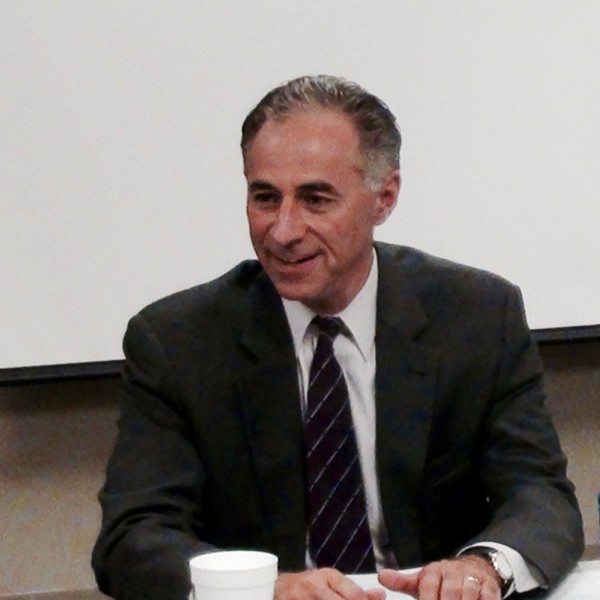
The laid off social workers, said DiBiase, will have a chance to apply for one of the more than fifty job openings at DCYF (Department of Children, Youth and Families). The layoffs are required, said Affigne, because of a “new staffing model” that will allow DHS to make significant cuts. The new model is “task based” and will not require supervisors trained in social work to manage by “case load.”
I asked Sue Pearlmutter, dean of the Rhode Island College School of Social Work if this means that the DHS is moving away from social workers advocating on behalf of clients and towards data entry technicians assisting clients using the computers.
“That has been my impression,” said Pearlmutter. The DHS is moving towards “a very different kind of process. Social workers engage with the client and work with the client.” The application process DHS is instituting makes “people take responsibility for their application at a kiosk or in a library.”
Often, these are “people in crisis” at a time when “completing an application is a daunting process.” Some adults and young adults, says Pearlmutter, “may find the process overwhelming. Removing a level of staff may cause more problems for people facing crisis.”
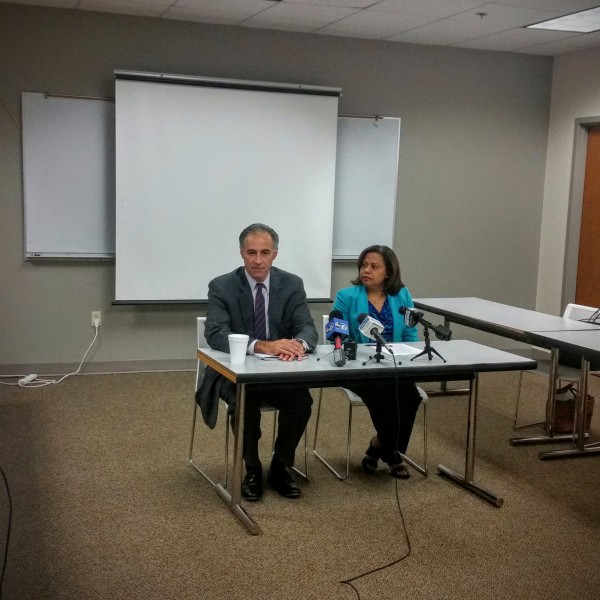 As for the staff DHS is cutting, saying that there are openings at DCYF is disingenuous. Many of the staff losing their positions at DHS started at DCYF, said Pearlmutter. They took jobs at DHS “because the work at DCYF is so crisis oriented. It’s difficult and emotional work that many found they couldn’t do any more.”
As for the staff DHS is cutting, saying that there are openings at DCYF is disingenuous. Many of the staff losing their positions at DHS started at DCYF, said Pearlmutter. They took jobs at DHS “because the work at DCYF is so crisis oriented. It’s difficult and emotional work that many found they couldn’t do any more.”
Talking about the jobs at DCYF as being like the work at DHS “shows no understanding of the kind of work social work is,” says Pearlmutter.
The new computer system, which has no official name, it’s just the “New Integrated Eligibility System,” said Affigne, was supposed to be online in July, and is now slated to be operational in mid September. The system will reduce the amount of time prospective clients will spend with social workers. This is “by far the largest technology project that has ever been undertaken by the State of Rhode Island,” said DiBiase.
The new computer system, said Affigne, is an “incredible tool for our workforce” that will “enhance customer service.”
Lucie Burdick, president of Local 580 of the Service Employees International Union (SEIU), disagrees. She told RI Future that “this extremely expensive computer system, if it even works correctly someday, will never provide the quality of service a trained, educated, experienced human being provides. The computer pilot program is failing miserably at this point and costs are rising rapidly. It could have been done better and cheaper. The displacement of staff and the cost of human suffering that it has exacted on the population we serve is unconscionable.
“This fiasco is the 38 Studios of human services. The taxpayers and advocates for the poor should be outraged.”
DHS provides people in need with access to many services such as Medicaid, SNAP benefits, Rhode Island Works (RIW), Child Care Assistance Program (CCAP), LTSS, General Public Assistance (GPA) and access to various energy assistance programs like HEAP, WAP and HSR. Affigne said that about one in five Rhode Islanders use services offered at the DHS, and that they maintain six field offices, like the one in Woonsocket.
“What will be the impact on clients?” I asked.
Affigne replied, “There will be no impact on clients.”
Yet existing clients did not start receiving notifications of reduced services in Woonsocket until August 23, and the Woonsocket DHS began reduced services on the 19th. That’s two or thee days of people arriving at the Woonsocket offices and learning that they were in for a four hour bus ride to Pawtucket from a sign taped to the door.
As Bob Plain and I tried to ask questions to get to the heart of the issue of the actual impact that this transition will have on people trying to access needed state services, Kristin Gourlay, health care reporter for RIPR cut in.
“Presumably,” said Gourlay, “in September, when the system goes live, people won’t have to go to a field office, they can go to- if the have a computer at home they can use that, they could go to a public library and use a computer there or another social service agency…”
“Correct,” said Affigne.
This allowed DiBiase and Affigne to shrug off concerns about social workers and clients as mere “bumps” along the way towards an improved, (read: cheaper) system. Yet, at a time when poverty and income inequality are at all time highs, and the economy of Rhode Island is barely improving, “bumps” in the lives of the one in five Rhode Islanders applying for needed assistance can be catastrophic.
Here’s the video of RIFuture’s questions:
Here’s the video of the full press conference:
]]>
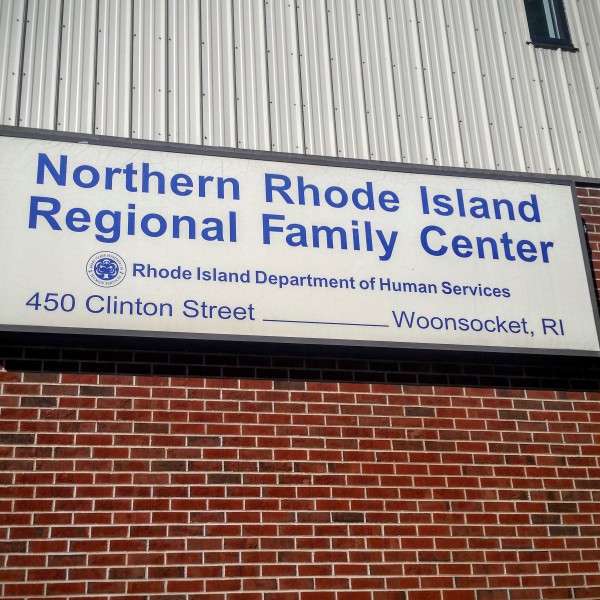 People in need of social services are being turn away from the Woonsocket branch of the RI Department of Human Services (DHS) as the offices are in the midst of a downsizing and relocation.
People in need of social services are being turn away from the Woonsocket branch of the RI Department of Human Services (DHS) as the offices are in the midst of a downsizing and relocation.
On Tuesday some clients went to the DHS offices in Woonsocket and were told that they could not access the services they needed. They were referred to the Pawtucket offices, requiring a four hour bus ride, two hours each way. DHS employees in Woonsocket said their branch right now can only deliver “limited services.” I was told that all questions regarding the move and reduced services needed to be referred to DHS director Melba Depeña Affigne.
The reason for the change in service seems to be related to 70 layoffs at DHS that, according to a news release, is the result of a new software system coming in September.
“Moving from a software system designed more than 30 years ago to a modern, digital system requires different staffing needs,” said Depeña Affigne in a news release from the Department of Administration sent today. There will be a 3pm press conference explaining the layoffs in detail.
“The new eligibility and enrollment software system will make it easier and more convenient for Rhode Islanders to access those vital services,” Depeña Affigne said in the press release.
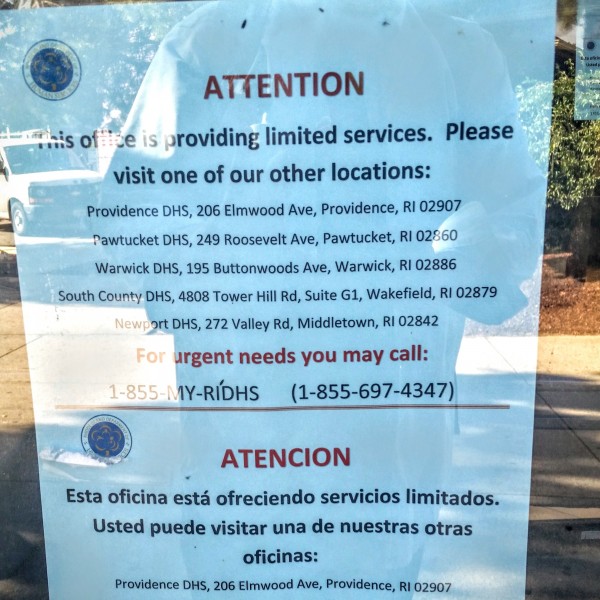
DHS provides vital community and family assistance by way of food and cash assistance, child care assistance and Medicaid. DHS manages SNAP benefits, Rhode Island Works (RIW), Child Care Assistance Program (CCAP), LTSS, General Public Assistance (GPA) and provides access to various energy assistance programs like HEAP, WAP and HSR.
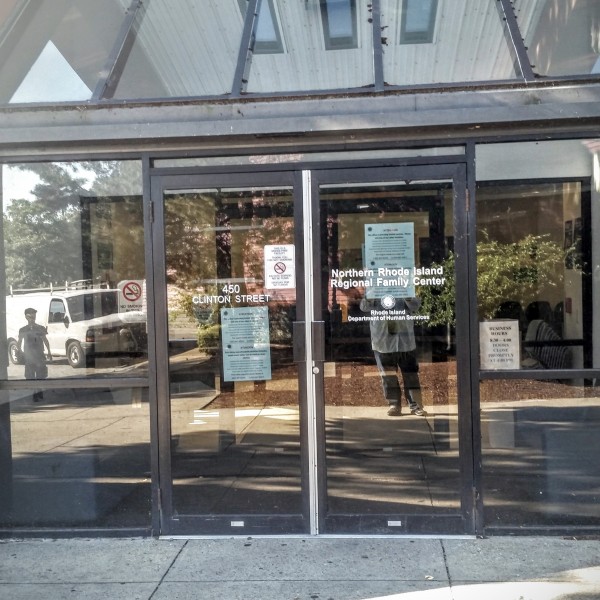 The clients DHS serve are among the most vulnerable in the state, who often have difficulty with transportation and access to the internet. Closing offices, downsizing staff and limiting services, even if only for a month, could have catastrophic effects on families.
The clients DHS serve are among the most vulnerable in the state, who often have difficulty with transportation and access to the internet. Closing offices, downsizing staff and limiting services, even if only for a month, could have catastrophic effects on families.
In a letter to SNAP Advisory Committee members, SNAP Administrator Iwona Ramian wrote that the lease for the current offices expires on August 31, and the effective date for the new offices is September 1, with transition between offices beginning Monday, August 22. Notification of the move was mailed to clients on Monday, meaning many people did not know about the gap in services.
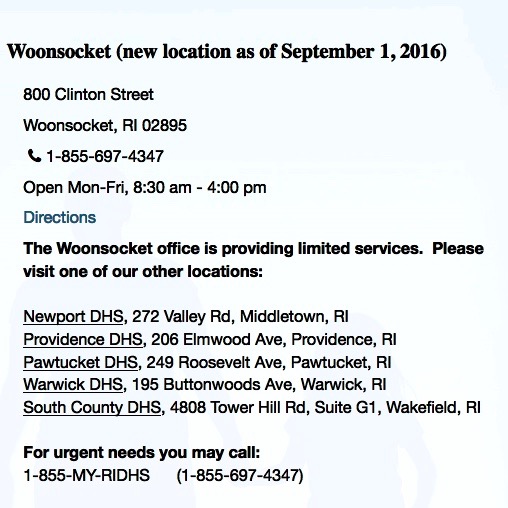
Though Ramian in her letter says that “no gap in services is anticipated” the DHS website says, “The Woonsocket office is providing limited services” and refers clients to other locations.
Further calling Woonsocket DHS services into question is Ramian’s assertion that staffing levels at the Woonsocket office will be reduced from 36 to 14. The 22 employees who will no longer be in Woonsocket are being relocated to Providence.
A drop to 14 staff members is a big reduction. The implementation of a new on-line system for determining eligibility and needs was supposed to be in place before the change in location and reduction in staff, but the new system is experiencing delays.
Ramian notes that “the [new] office space will be shared with a comprehensive multi-service, non-profit, health and human services agency, giving customers a one-stop service location. The office telephone and facsimile numbers will stay the same. She’s referring to Community Care Alliance, a multi-service not-for-profit health and human services provider consisting of the original community mental health center serving the 6-town region, a school, the Woonsocket Family Shelter, the Northern RI Family Visitation Center (for DCYF-involved families), a youth success program, day treatment, partial hospital and acute stabilization for substance use and co-occurring behavioral health disorders and more.
Calls to the DHS offices have not been returned.
]]> Many worthwhile organizations doing important work found out that they had lost their grants when the budget was unveiled. Among those is Youth Pride Inc. (YPI). Having lost their Community Service Grant, the group now faces a $50 thousand shortfall. YPI is the only group in Rhode Island that specifically serves the needs of LGBTQ youth in the state.
Many worthwhile organizations doing important work found out that they had lost their grants when the budget was unveiled. Among those is Youth Pride Inc. (YPI). Having lost their Community Service Grant, the group now faces a $50 thousand shortfall. YPI is the only group in Rhode Island that specifically serves the needs of LGBTQ youth in the state.
YPI has sent an email to supporters, asking them to contact their legislators in the hope of having these funds restored.
We are asking our supporters to let the state know how valuable and important Youth Pride Inc.’s work with LGBTQQ youth is to our state and community. Let them know we are the only organization providing support and advocacy for LGBTQ youth in the state! Let them know that these youth need our organization!
“Please reach out to the Speaker of the House and Senate President immediately in support of YPI and the vital work that we do for LGBTQQ youth in Rhode Island TODAY. The Senate President can be contacted at: 401-222-6655 and the Speaker of the House can be reached at: 401-222-2466. Please reach out to your Representative as well.”
At yesterday’s House Budget briefing, I asked Speaker Nicholas Mattiello about the cuts to the program. He said that YPI serves a “very worthwhile purpose” but added, “Those services, needs, potentially are being serviced elsewhere.”
In the case of YPI, the Speaker said that he had heard the suggestion that, “guidance counselors in the school are in fact providing [these services]. Not specifically [for LGBTQ youth] but it’s something that is being addressed through other means.”
Given the range of services and programs YPI provides that specifically cater to the needs of LGBTQ youth in Rhode Island, it’s unlikely that guidance counselors are filling that need or have the time and ability to do so. That said, Mattiello, added towards the end of his statements, “We’ll take a look at [YPI] and we’ll see if it’s unique enough to fund.”
Representative Joseph Almeida entered the Budget Briefing late and asked about other worthwhile groups that have been denied funding, including the Opportunities Industrialization Center (OIC) which has provided employment training and placement opportunities since 2010 and the Institute for the Study and Practice of Nonviolence which works to reduce homicides and support victims of violence.
“It’s like all the poor people got cut, cut, cut,” said Almeida, who said afterwards that he was speaking from his heart, “Can’t you take money from Crossroads and give to people who really need it teaching peace in the streets and teaching people how to get jobs? I mean Crossraods? What? What do they do?”
Crossroads RI received $300,000 in the budget.
]]>working at a full-time job
and getting part-time income.”
– Dr. Martin Luther King
Are you poor? Have you ever been poor?
In 1981, I faced significant financial troubles. My bride and I moved to Louisville so I could attend seminary. Our checking account, often near zero, required much attention. With low-wage jobs, my wife and I limited our entertainment to the local dollar theater.
One day, a clerical error led to a bounced check. The seminary charged $20. This was a fortune! With this money, we could have gone to the movies ten times.
We were not alone. So I asked the seminary to reduce its exorbitant fine. Administrators refused. I expected better understanding from an institution teaching God’s love for the poor.
Was I poor? I thought so. Now I consider it a ‘struggle.’ After all, time would improve our circumstances and, if needed, both our parents could help us.
Not so for many who really are impoverished. For them, a bounced check can take food off the family table. The USDA reports in 2014 that 6.9 million American households, many with children, had “very low food security.” At various times, their food intake was reduced and their eating patterns disrupted.
 This is shocking. Political will has been absent to fully fund the SNAP (food stamp) program. Indeed, SNAP is subjected to repeated cuts by those who insist government is encouraging poor people to be “dependent” upon assistance. Even families with short-term hunger crises must not be given adequate food.
This is shocking. Political will has been absent to fully fund the SNAP (food stamp) program. Indeed, SNAP is subjected to repeated cuts by those who insist government is encouraging poor people to be “dependent” upon assistance. Even families with short-term hunger crises must not be given adequate food.
In such cases, government’s closed-fisted stinginess demeans the lives of those whose finances are already far too painful. It’s the same sin as my seminary—only the offense is far greater because our national cruelty is reflected by Americans’ anguish from hunger.
The U.S. has 4.4 percent of the world’s population—but 45 percent of the world’s ultra high net worth individuals (38,000 with wealth of at least $50 million). Yet we won’t feed our own—including our children: Despite our riches, U.S. childhood poverty is ranked 34th of 35 developed nations.
For my wife and me, financial difficulties were short-term. Soon, we would have enough income to save for a rainy day.
Not so for the 62 percent of Americans with savings unable to cover a $500 emergency. For millions of low-income Americans, a safety net is crucial.
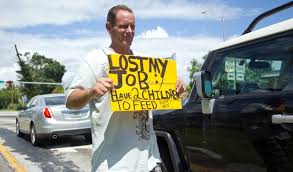 Here are a few comments from those in poverty:
Here are a few comments from those in poverty:
Sharon existed on $500 a month for seven years. She states, “I feel rich when I have food.”
Mary Lee had a good income. Her business tanked, so her home is now her car or a friend’s couch. She survives on Ramen noodles and has one pair of pants. Living in poverty, says Mary Lee, is “very humiliating” and she is worn down by “hellish stress.” She explains, “It feels like falling in the ocean and treading water for years…. [Poverty] devastates your ability to function and robs you of your health.”
KC and his wife earn minimum wage—when jobs are available. They avoid anything but necessities. KC states, “Income inequality is worse stress than any job.”
Tania, a single mother, somehow pays her rent while making less than $11,000 a year. Without food stamps, she says, “we couldn’t eat.” With recent government reductions, however, she runs out of milk, juices, bread and eggs before the end of each month. “It’s difficult when one child is only three.”
Despite hard work, many paid at or near minimum wage remain in poverty for years. Good opportunities in America should include a living wage for all.
Everyone must eat. Instead of slashing assistance, it’s time to restore food stamp cuts. Like Jesus, we ought to “bring good news to the poor,” be compassionate, and assist them in overcoming the oppression of poverty.
SOURCES
USDA: http://www.ers.usda.gov/topics/food-nutrition-assistance/food-security-in-the-us/key-statistics-graphics.aspx#insecure
45% of uhwi/bottom chart shows U.S. has 38,000; print specifies world has 84,500: http://www.zerohedge.com/news/2013-06-02/its-1-world-who-owns-what-223-trillion-global-wealth
U.S. is 34th in childhood poverty: http://www.commonwealthfund.org/publications/fund-reports/2014/jun/mirror-mirror
62 percent with no emergency savings: http://www.marketwatch.com/story/most-americans-are-one-paycheck-away-from-the-street-2015-01-07
Testimonies: http://america.aljazeera.com/articles/2014/1/15/stories-from-thewaronpoverty.html
]]> City Year was founded in 1988 by Harvard Law School room mates Michael Brown and Alan Khazei. Their original vision was to create a young adult organization that would function as a kind of domestic Peace Corps and that bore some resemblance to the New Deal Civilian Conservation Corps. In the first few years, the program, based out of Boston, was a halting success, mainly involved in a series of public works and betterment efforts that were well-intentioned but did not make the gigantic impacts in the original dreams of the founders. There were also typical start-up problems every non-profit faces when its volunteers are in that age bracket, such as absenteeism/tardiness and poor behavior. They began with after-school programs, a weekend youth group called Young Heroes, and literacy tutoring, as well as the foundation of AmeriCorps, based on the City Year model. That all changed in 2010 when the organization, now in multiple cities across the nation, adopted a full-time school-based program, focused on student attendance, behavior, and course performance. However, underneath the red jackets, their laid a set of steps that played right into the hands of the neoliberal policy agenda.
City Year was founded in 1988 by Harvard Law School room mates Michael Brown and Alan Khazei. Their original vision was to create a young adult organization that would function as a kind of domestic Peace Corps and that bore some resemblance to the New Deal Civilian Conservation Corps. In the first few years, the program, based out of Boston, was a halting success, mainly involved in a series of public works and betterment efforts that were well-intentioned but did not make the gigantic impacts in the original dreams of the founders. There were also typical start-up problems every non-profit faces when its volunteers are in that age bracket, such as absenteeism/tardiness and poor behavior. They began with after-school programs, a weekend youth group called Young Heroes, and literacy tutoring, as well as the foundation of AmeriCorps, based on the City Year model. That all changed in 2010 when the organization, now in multiple cities across the nation, adopted a full-time school-based program, focused on student attendance, behavior, and course performance. However, underneath the red jackets, their laid a set of steps that played right into the hands of the neoliberal policy agenda.
When I graduated Rhode Island College in 2009, I was facing a lack of job prospects and no medical coverage to pay for a variety of prescription drugs that I take for several chronic illnesses. City Year appealed to me for several reasons. First, as an Eagle Scout, I have an inclination towards voluntary service. Second, City Year provided full health insurance. Third, those who graduate the program are eligible for the Segal AmeriCorps Education Award, which I used to pay off one of my student loans. As a member, I was part of the Young Heroes team. During the week, we would run after school programming at Bridgham Middle School, which is on a side street between Broadway and Westminster Street in Providence adjacent to the entrance to Olneyville. After the New Year, we took up the youth program on Saturdays, hosting hundreds of youth as we ran a variety of activity modules intended to promote better citizenship.
For pay, we were given a stipend of less than $1,000 per month. I lived at home to save on room and board, but my fellow Corps members, who came from across the country, were encouraged to get Food Stamps and budget wisely. The argument for this does have a Francis of Assisi-like quality, encouraging one to live with the means of those one serves, but there remains a simple question, why would then-Mayor David Cicilline spend all this money to host a City Year organization instead of just hiring more teachers? Should a Democratic Party-majority municipality with a major education infrastructure problem be sending funds to a non-profit or invest it in upgrading the schools? Was it not John Maynard Keynes who said that, especially in a recession akin to ours in 2009, the way to get out of the slump is to increase public spending and hiring of good-paying, unionized public workers?
The Democrats have long supported neoliberal agenda in regard to education. Figures like Cory Booker and Arne Duncan, considered superstars in the mainstream, have been major proponents of the charter school movement and war on teacher unions. Since Vincent “Buddy” Cianci left the Mayor’s office, there have only been Democrats elected to power, yet the roll-out of charter schools and so called “education reform” policies like Common Core, standardized testing, and teacher evaluations are unchallenged. It is easy for the media to demonize certain figures, such as former Education Commissioner Deborah Gist, but it is unheard of to see neoliberalism discussed within the pages of the Providence Journal.
One of the elements of City Year I found most problematic was its so-called ‘Culture of Idealism’. It consists of a hodgepodge collection of parables, sayings, and directives that are meant to inspire the Corps. This problematic because it throws together a variety of historic personages from radically different socio-political backgrounds and outlooks in the name of this thing called ‘idealism’. Is it appropriate to quote first the anti-choice Mother Theresa and then Nelson Mandela, who legalized abortion in South Africa following his election? Would Martin Luther King, Jr., who died in the midst of developing a democratic socialist outlook meant to challenge the poverty inherent in racism and capitalism, enjoy being lumped together with the same Red-baiting Robert Kennedy that bugged his hotel rooms and phones?
Who cares? Idealism!
There is a long history of genuine education reform in the art of teaching. For example, it was the Brazilian Paolo Freire’s 1968 Pedagogy of The Oppressed that radically redefined the teacher-student dynamic and challenged basic institutional assumptions about learning, kicking off what has come to be known as the critical pedagogy movement. Freire utilized the Marxist analysis of colonialism and combined it with his own observations about how students are treated as piggy-bank-like vessels to be filled with knowledge. He said instead that the teachers must collaborate with the pupil to create knowledge, derived from the model of education proscribed by John Dewey. However, with City Year, there is no engagement with this kind of logic. Instead, there is re-enforcement of Common Core and other principles that are actually contributing to the drop-out crisis. The organization claims they want to plug the school-to-prison pipeline, but they traffic in material and philosophy which accomplishes the opposite.
This can be attributed to the fact that the people in charge of City Year Providence and the wider organization are not educators. The Board does include a few people with some experience in education, but what business does Andrew Viens of Bain Capital or Andrew Capalbo of Locke and Lord law firm have in education?
The training I received in 2009 has since changed, so things are different today. When I was there, there was a transition in process and there were members at the highest level who were creating new ideas. However, the simple fact remains that collaboration in the neoliberal agenda continues. There is no evidence of interest in Freire’s ideas, just white papers explaining how to implement Common Core better.
Furthermore, City Year also participates in other neoliberal education trends that are much more problematic. For example, they place alumni in the union-bashing Brooke Charter Schools, which are intended to field-train teachers without proper education in college. When I was exiting the Corps, one option for alumni was the likewise union-busting Teach for America organization. A recent report by Glen Ford at Black Agenda Report explains the major deficiencies in the Teach for America program. The report begins at 24:46 in the broadcast and can be heard by clicking here.
The war on public education includes union busting but also the destruction of teacher tenure. This is because, even if you are protected by a union, you can still have your position phased out. Why? This gets to the very core of being a teacher: As highly-educated working people, they have the capacity, skill set, and oftentimes drive to be community leaders, figures that can and often do fight for equality.
Consider this thought experiment:
Let us suggest that perhaps you have a Social Studies teacher in a middle school. As part of a yearlong assignment, the class is asked to do a news analysis assignment wherein they track a recurring set of stories about a politician who is quite close to the charter school industrial complex. Suddenly, on the occasion when the charters get a huge pile of money to open new locations while the public schools are in shambles, the students read the writing on the wall and understand the systemic failure. They begin talking about holding walkouts, protests, sit-ins, all sorts of direct actions. These kids, in the midst of hormonal upsurge, need a teacher to guide them through direct action politics, help them understand what it means to make demands, and how to gauge results as either success or failure. In short, they need a teacher, protected by tenure, who can speak truth to power.
Things were further complicated by ethical challenges I faced when I was in City Year. When we did outdoor service, work that should have rightfully been done by properly-trained and paid Providence city employees, we were given zero instruction about equipment safety.
There are now 27 City Year locations across the country. I did a brief cross-section of these locations with locations cited in a 2013 article by In These Times that named five cities in the midst of a neoliberal takeover. Several of them also have City Year programs in their states and are the homes of prominent education deformers like Arne Duncan, Bill Strickland, Eric Hanushek, Bill and Melinda Gates, and Michelle Rhee..
The question now becomes a simple one, can City Year shed its neoliberal tendencies and become an agent for positive change? That is a difficult question. The idea that individuals untrained in the pedagogical methods can jump in and out of a troubled school district and affect students positively within the course of a school year is problematic at best. Serious re-calibration of their training modules with accredited institutes of higher education, such as Rhode Island College, to create certified teacher’s aides is the most tenable solution that comes to mind. Currently one can gain certification to become a TA after 18 hours of training with an accredited organization and passing the ParaPro test if one does not hold a college degree. In the place of City Year, Providence could be hiring qualified TAs with ease.
The only problem is the TAs are unionized and receive benefits and pension for their work, something Corps Members do not get from their service. And just to be clear, I would not want to make it seem like I am bashing anyone, a systemic critique in the Marxist vein I aim for is instead based around a political economy of structural nuances. The people who join City Year have the best of intentions and should be highly respected for this effort. But, to borrow from the logic of Slavoj Zizek, the ideological matrix is such that they do not know that they are actually contributing to a status quo of education failure.
But this would also require a much higher standard for applicants and tougher screening. It would also behoove the organization to become more integrated with the American Federation of Teachers and other labor organizations. Of course, that would also risk the Corps members trying to unionize for better pay, especially now that free healthcare is the law and not a membership perk. This is a difficult matter, but I imagine some idealism will help them figure it out.
]]> On March 4th 2016, I attended a CSEC (Commercial Sexual Exploitation of Children) training by DayOneRI at the Warwick Public Library. Sara Eckhoff was the trainer and when she started her Powerpoint presentation I almost fell out of my chair. This time DayoneRI was claiming that there were 330,000 US children being exploited in the US and that the pimps and traffickers were making 8 billion dollars a year. Yet we know this myth was also recently proved to be false by the Washington Post’s fact checker.
On March 4th 2016, I attended a CSEC (Commercial Sexual Exploitation of Children) training by DayOneRI at the Warwick Public Library. Sara Eckhoff was the trainer and when she started her Powerpoint presentation I almost fell out of my chair. This time DayoneRI was claiming that there were 330,000 US children being exploited in the US and that the pimps and traffickers were making 8 billion dollars a year. Yet we know this myth was also recently proved to be false by the Washington Post’s fact checker.
Eckhoff then said that the average age of entry was 14 and when I corrected her, she went on to say that CSES has seen 14 be the average age of entry based on the children they are working with. However, she then said that the program she works with through DayOneRI only includes kids up until age 14. Eckhoff also reconfirmed that DayOneRI does not house any of these children and that rescued children get placed into foster homes.
Eckhoff then explained how pimps are grooming kids, and how gang members were tattooing the victims and how the pimps were waiting down the road from the foster homes. Eckhoff told us one sign of trafficking is when teenage girls start wearing mini skirts and that they might even become sexually promiscuous. Elizabeth Nolan Brown has highlighted the damage caused by these hysterical myths here.
Eckhoff also mentioned that DayOneRI has to meet with the teens an average of 6 times before the teenagers will open up to them, and that these teens are just looking for love and a sense of family. Yet she couldn’t seem to explain why the teenagers keep running away.
I tried to tell Eckhoff that half the youth interview report that police officers force them to have sex in lieu of going to jail. Eckhoff didn’t react and continued stigmatizing these teenagers.
I mentioned how DayOneRI was part of the RI Trafficking Task Force and how they just did an “End the demand sting” in Cranston and arrested 13 men. Eckhoff directed my question to another DayOneRI rep at the back of the room, who tried to deny this. I pressed on and said it was published in the media that the sting was done as a group effort by the RI Trafficking Task Force, at which time she said that people were only arrested if they had outstanding warrants. I asked, how arresting clients helps trafficking victims. The rep offered to speak to me outside privately after the training which demonstrated to me that DayOneRI has no interest in transparency and has a lot of interest in silencing sex workers who have different narratives.
I tried to tell Eckhoff that the majority of youths interviewed report that they don’t have pimps and that they teach each other how to find clients. Eckhoff responded that this isn’t what they see at DayOneRI. I told Eckhoff that the data shows that more teens were being arrested for prostitution in the 80’s and 90’s than in most recent years and we just have a new name for an old problem. The new name is sex trafficking and the problem is runaway and thrown away kids. But that didn’t slow Eckhoff down, because five seconds later she was telling the audience that sex trafficking is on the rise.
So I tried a different approach. I explained that 97 percent of all sexual abuse on children happens by someone the child knows and only 3 percent happens in the sex industry. I asked Eckhoff why we are not teaching the public how to identify kids that are being sexually abused by someone they know. After all, she just told us 90 percent of sex trafficking victims were sexually abused as kids. Sara says that she understands 97 percent of abusers are someone the child knows, but this training was just on CSEC.
Now you would think the audience would be happy that there was someone in the room that had accurate information, however one woman had the nerve to say that she wanted me to stop asking questions and to stop correcting Eckhoff. The woman told us how she thinks there use to be a brothel in her neighborhood, and how it must have been shut down, because now it was a Church.
Eckhoff explained how people could access “the victims compensation program.” I told her that anyone involved in prostitution was not eligible for that program and how we had to fight to get that regulation changed in CA and how this would be a great goal to work on in RI. At this point Steve Morley came to my defense and confirmed what I had said was true. He is the new department head at DCYF (Department of Children, Youth & Family). Morley explained he was retired law enforcement and I felt that he understood the reality people in the sex industry lived in.
DayOneRI told the public that gangs were raping girls and forcing them into prostitution. I wonder how many young men from poor communities will be victimized during the next, “End the demand sting” or the next time the RI Trafficking Task Force interrogates a minor caught working as a underage sex worker.
COYOTE RI would like others to utilize our experts and experience and we are willing to offer free trainings to all service providers, law enforcement and DCYF workers.
Here is a study on 45 trafficking victims from 32 states. 90 percent of them were arrested, not rescued. Some have been arrested 20 or 30 times and services were only offered to those who played the victim role.
Tara Burns of CUPS (Community United for Safety and Protection) has found similar findings in her survey of Alaska Sex Workers and trafficking victims.
So far we have surveyed 43 New England Sex Workers. Some of the most interesting findings thus far are that 77 percent of respondents reported that they have never tried reporting a crime while working in the sex industry. For those who did try making a report to the police, 77 percent said the police did not take their report. 4 percent were arrested while trying to report a crime. 26 percent report being threatened with arrest while trying to report a crime. 29 percent said they did not report the crime because they thought they would be arrested. 27 percent said they did not report the crimes because they didn’t think the police would do anything and 32 percent did not report because they didn’t want to draw attention to themselves or their co-workers. This and other similar data reveal how sex workers bear the negative consequences of anti-sex trafficking policing.
Also by Bella Robinson:
DayOne peddling ineffective and costly sex trafficking programs
]]>

